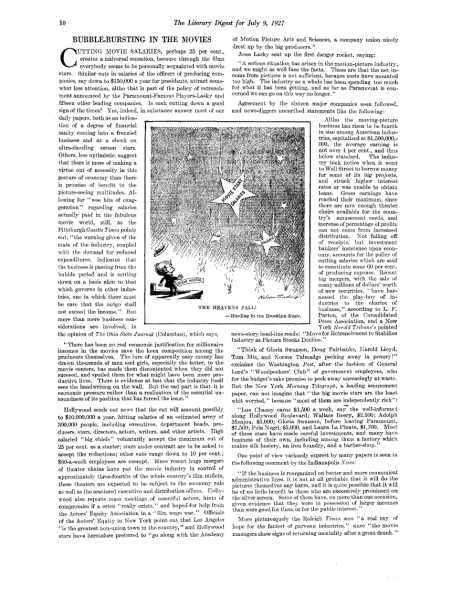| Artifact Type | Mainstream Media, Sources |
| Publication | The Literary Digest |
| Volume | XCIV |
| Number | 2 |
| Page Number | 10 |
| Place | New York |
| Publication Date | July 9, 1927 |
| Transcript | Show/Hide |
|
Headline: “Bubble-bursting in the Movies” Cutting movie salaries, perhaps 25 per cent., creates a universal sensation, because through the films everybody seems to be personally acquainted with movie stars. Similar cuts in salaries of the officers of producing companies, say down to $150,000 a year for presidents, attract somewhat less attention, altho that is part of the policy of retrenchment announced by the Paramount-Famous Players-Lasky and fifteen other leading companies. Is such cutting down a good sign of the times? Yes, indeed, in substance answer most of our daily papers, both as an indication of a degree of financial sanity coming into a frenzied business and as a check on ultra-dazzling screen stars. Others, less optimistic, suggest that there is more of making a virtue out of necessity in this gesture of economy than there is promise of benefit to the picture-seeing multitudes. Allowing for “wee bits of exaggeration” regarding salaries actually paid in the fabulous movie world, still, as the Pittsburgh Gazette Times points out, “the warning given of the state of the industry, coupled with the demand for reduced expenditures, indicates that the business is passing from the bubble period and is settling down on a basis akin to that which governs other industries, one in which there must be care that the outgo shall not exceed the income.” But more than mere business considerations are involved, in the opinion of The Ohio State Journal (Columbus), which says,
Hollywood sends out news that the cut will amount possibly to $10,000,000 a year, hitting salaries of an estimated army of 300,000 people, including executives, department heads, producers, stars, directors, actors, writers, and other artists. High salaried “big chiefs” voluntarily accept the maximum cut of 25 per cent, as a starter; stars under contract are to be asked to accept like reductions; other cuts range down to 10 per cent.; $50-a-week employees are exempt. Since recent huge mergers of theater chains have put the movie industry in control of approximately three-fourths of the whole country’s film outlets, these theaters are expected to be subject to the economy rule as well as the scattered executive and distribution offices. Hollywood also reports mass meetings of resentful actors, hints of compromise if a crisis “really exists,” and hoped-for help from the Actors’ Equity Association in a “film wage war.” Officials of the Actors’ Equity in New York point out that Los Angeles “is the greatest non-union town in the country,” and Hollywood stars have heretofore preferred to “go along with the Academy of Motion Picture Arts and Sciences, a company union nicely drest up by the big producers.” Jesse Lasky sent up the first danger rocket, saying:
Agreement by the sixteen major companies soon followed, and news-diggers unearthed statements like the following: Altho the moving-picture business has risen to be fourth in size among American industries, capitalized at $1,500,000,000, the average earning is not over 4 per cent., and thus below standard. The industry took notice when it went to Wall Street to borrow money for some of its big projects, and struck higher interest rates or was unable to obtain loans. Gross earnings have reached their maximum, since there are now enough theater chairs available for the country’s amusement needs, and increase of percentage of profits can not come from increased distribution. Not falling off of receipts, but investment bankers’ insistence upon economy, accounts for the policy of cutting salaries which are said to constitute some 60 per cent. of producing expense. Recent big mergers, with the sale of many millions of dollars’ worth of securities, “have harnessed the play-boy of industries to the chariot of business,” according to L. F. Parton, of the Consolidated Press Association, and a New York Herald Tribune’s pointed news-story head-line reads: “Move for Retrenchment to Stabilize Industry as Picture Stocks Decline.” “Think of Gloria Swanson, Doug Fairbanks, Harold Lloyd, Tom Mix, and Norma Talmadge pecking away in penury!” exclaims the Washington Post, after the fashion of General Lord’s “Woodpeckers’ Club” of government employees, who for the budget’s sake promise to peck away unceasingly at waste. But the New York Morning Telegraph, a leading amusement paper, can not imagine that “the big movie stars are the least whit worried,” because “most of them are independently rich”:
One point of view variously exprest by many papers is seen in the following comment by the Indianapolis News:
More picturesquely the Raleigh Times sees “a real ray of hope for the fattest of parvenu industries,” since “the movie managers show signs of returning mentality after a great drunk.” |
|
| Archive | UNZ.org |
| Read In Context | http://www.unz.org/Pub/LiteraryDigest-1927jul09-00010 |
| Citation | “Bubble-bursting in the Movies,” The Literary Digest, July 9, 1927. |
| Tags | 1920s1927July 1927 |
